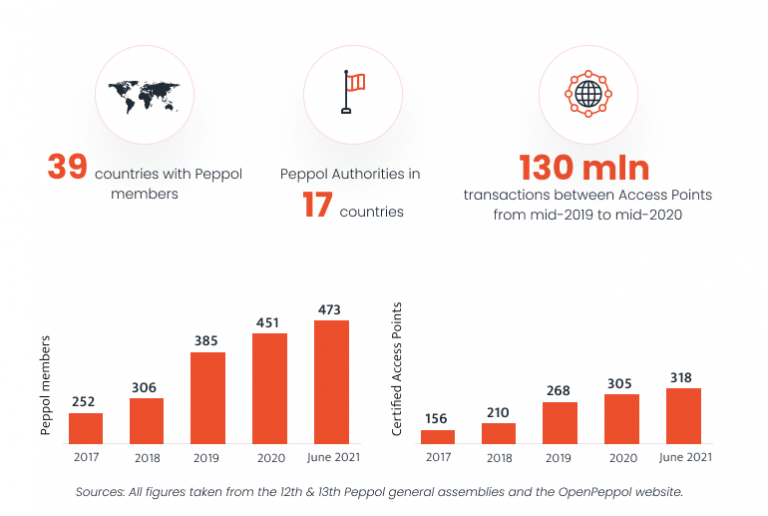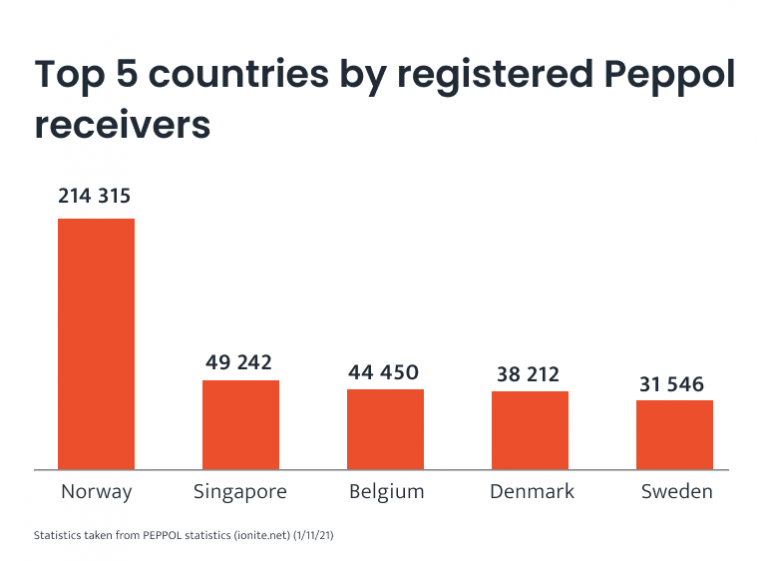Peppol Expansion – Statistics For Network Growth in 2021

Beginning as a European Union project to make cross-border e-procurement easier, securer, fairer, and more efficient, Peppol has grown into a network used around the world, increasingly employed by private companies and governments as part of their eInvoicing strategies. Peppol eInvoicing, which employs the 4-corner model to send and receive e-documents, has even served as the inspiration for the Business Payments Coalition (BPC), a network linked to the American Federal Reserve, who are pushing for a US eInvoicing framework that can be used by companies trading domestically and globally.
In this blog post, we will take a look at why the Peppol network is growing, where exactly Peppol is seeing the greatest penetration, and how a range of public and private organizations can benefit from the network.
Why is Peppol growing?
As we mentioned above, Peppol was originally developed in the EU, where public procurement makes up around 14% of the entire bloc’s GDP — equating to roughly EUR 2 trillion (according to 2017 EU estimates). This means that even small efficiencies can make for huge cost savings. Peppol — for the exchange of electronic documentation — works hand-in-hand with other initiatives such as the European Committee for Standardization (CEN), and Electronic Simple European Networked Services (eSENS) to coordinate, simplify, and digitize all parts of the e-procurement process. Reduction of costs is not the only benefit; there is also improved access for SMEs, who can more easily find and bid on tenders. This wider access, while being more democratic, also benefits the public sector through increased competition. E-procurement also brings greater transparency, making corruption more difficult, and vastly improves the quality of procurement data.
Peppol benefits
Focusing solely on Peppol, we can look to the benefits that are found when sending a Peppol eInvoice, so far the most common document type to be transacted through the network. We see:
1. Cost savings of roughly 66%, as estimated by the Australian Tax Office (ATO), the country’s Peppol Authority. Documentation from the European Commission reports similar results.
2. A reduction in errors and time spent, as manual input, handling, and recording of eInvoice data is largely automated.
3. Greater security, with verified Peppol participants sending documents across a secure network. Contrast this with PDF invoices transferred over email — the lack of proper security and oversight has given rise to a scourge of external invoice fraud.
4. The ability to connect once and reach all network participants. As we covered in our blog post on national eInvoicing standards vs. the Peppol standard, the need for individual B2B or B2G connections, such as those offered by VAN operators, are no longer needed. Peppol unites different service providers, so you have one set of standards — Peppol BIS (Business Interoperability Specifications) — and one connection to reach any trading partner around the world!
As working remotely has become the norm, issues of security, storage of important documents, and the management of manual processes have become even more important considerations than they were previously. It is within this context that Peppol provides a safe and easy-to-use network for transacting eInvoices, e-shipping notes, e-catalogs, and more.

Peppol penetration statistics
Moving beyond Europe, Peppol has members in 39 countries, with private companies in China, Mexico, Canada, and the USA joining the likes of Singapore, Japan, Australia, and New Zealand, whose governments have adopted the network at a national level. With this wider expansion, more certified Access Points are being established, as we can see from the infographic below.

Top 5 countries by registered Peppol receivers
The world’s governing Peppol Authority, OpenPeppol, operates the global Peppol Directory, where all participants with receiving capabilities are listed. Using this data, we can see where Peppol use is most prevalent. The number of advanced registered receivers in countries like Norway reflects B2B adoption, with an increasing number of private companies using Peppol as the preferred network to transact with partners locally, within the EU, and further abroad. This B2B represents the second wave of Peppol uptake, with (often) mandatory B2G use being the first step.

What’s next for Peppol
Peppol’s growth is to continue, with EU directive 2014/55/EU requiring public contracting authorities to use eInvoicing at the Peppol standard, and governments such as Australia, New Zealand, and Singapore mandating Peppol’s use for the public sector, as well as incentivizing it in the private sector. Japan has recently become the newest Peppol Authority, with speculation that Malaysia may soon follow.
Tickstar infrastructure for the Peppol network
With Peppol cementing itself at the network of choice for domestic and international e-document transactions, ERP vendors and service providers are gaining a competitive advantage from incorporating the Peppol network into their software. SAP and Xero, two of the biggest accounting software providers, offer Peppol services with infrastructure provided by Tickstar.
To gain a competitive advantage and grow your revenue stream, we offer rapid Access Point accreditation and Peppol connection that instantly complies with all Peppol authorities.
With the choice of shared instance and white labeled Access Points, you don’t have to worry about development, maintenance, hosting, or error handling. We cover all the technical aspects so you can simply concentrate on growing your client base and providing dependable and affordable Peppol services.
To find out more about becoming a Peppol Access Point provider for your business, or to take advantage of the newest features in our upgraded SMP, get in touch with our knowledgeable team today.



